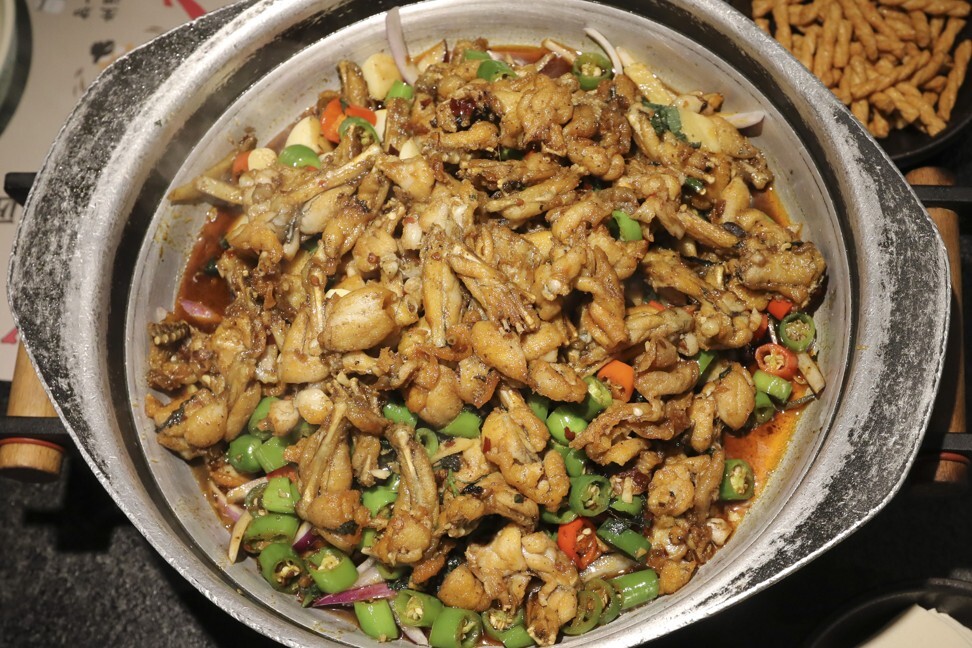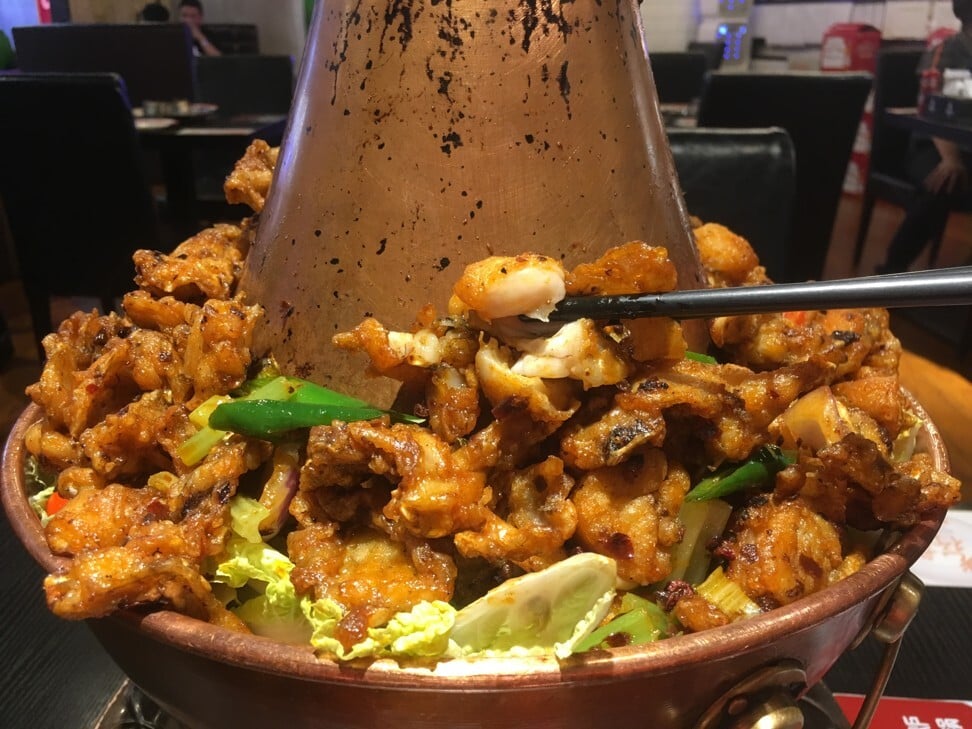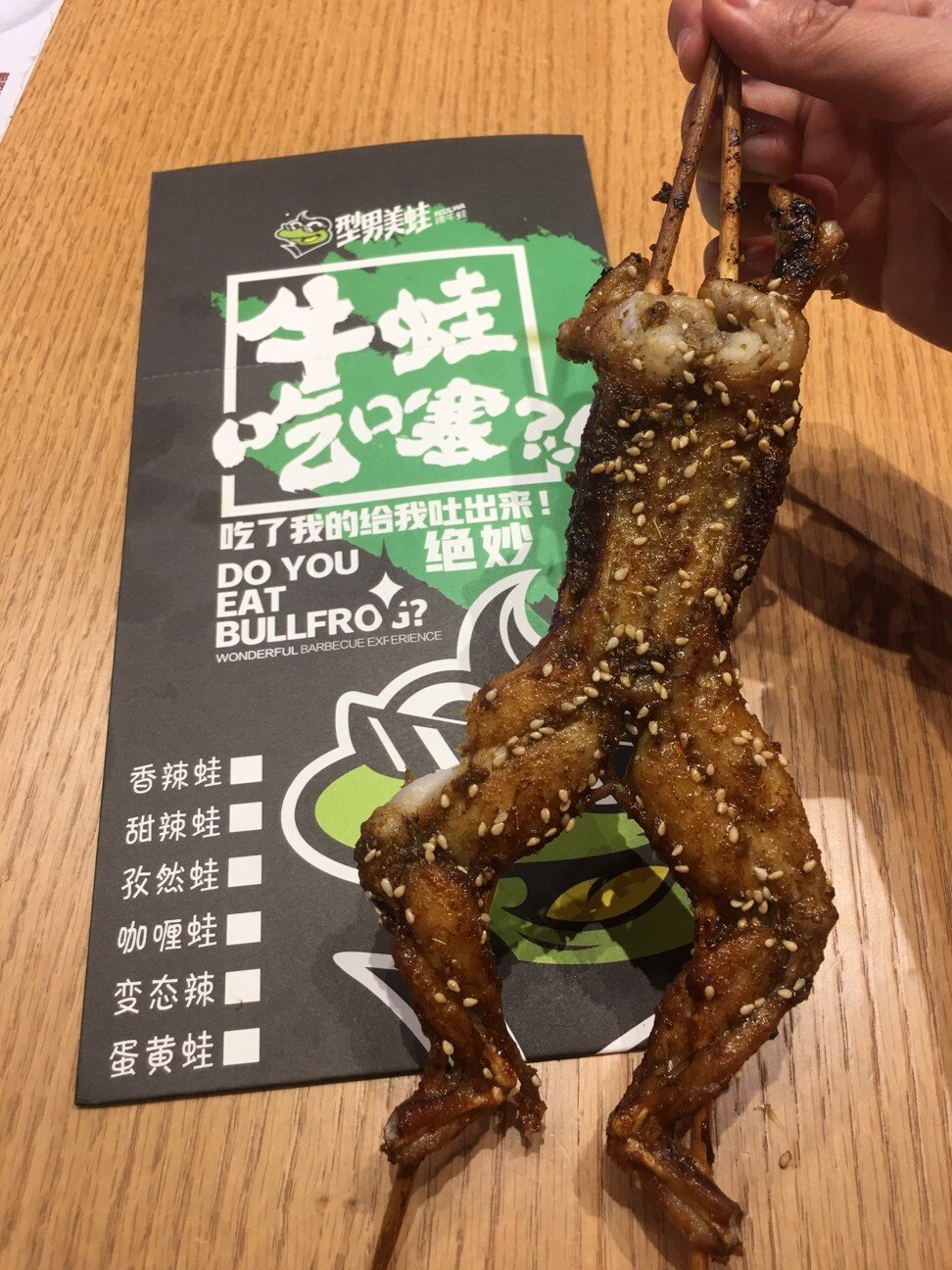
China’s frog restaurants prosper as appetite for delicacy known since the Ming dynasty explodes
- China has long dined on frogs, but a gift of bullfrogs from Cuba’s Fidel Castro helped feed a huge increase in the appetite for them in recent years
- Restaurant chains specialising in frog have sprung up, serving frog in hotpot, on rice and noodles, pan-fried, deep-fried, in soup and grilled
The business of frog breeding and consumption in China, estimated by Chinese media to be worth 50 billion yuan (US$7.6 billion), was plunged into uncertainty in February when the coronavirus outbreak prompted authorities to suspend the trading and eating of all animals that fell outside the categories of livestock and domesticated aquatic animals.
However, the industry heaved a sigh of relief a month later when the Ministry of Agriculture and Rural Affairs classified frogs as domesticated aquatic animals and exempted them from the ban.
The month-long suspension shone the spotlight on a rapidly expanding industry which, according to dining industry website New Catering Big Data, supplies 30,000 specialist frog restaurants across China.
The first Kungfu Froggy restaurant opened in the southern city of Nanning in 2015 and has since spawned a chain of more than 180 restaurants. Co-founder Jennifer Jiang says when the restaurant started, the specialist frog restaurant industry was practically non-existent.

“The other co-founder, Eric Xia, comes from Hunan. He loves spicy braised frog from his hometown, so he wanted to set up a specialist chain just like the ones for crayfish. Inspired by [the Hollywood animated hit] Kung Fu Panda, we came up with a wuxia theme for the restaurant chain,” she says.
“We have 14 kinds of frog dry pot and frog in soup cooked in Sichuan and Hunan styles. The pots have a vegetable and potato base. Frog dry pot with green pepper and perilla is the most popular dish. The garlic and Sichuan pepper ones also sell very well.”
China takes wild animals off the menu amid coronavirus epidemic
Jiang says they keep coming up with new dishes, such as frog boiling stone pot and frog with pork stomach. To ensure a stable supply of frogs, the company last year established two farms in China’s southern Guangxi region, in which Nanning is situated, that breed bullfrogs originating from Cuba.
China has much to thank Cuba for when it comes to frog breeding.
While the earliest record of frogs being eaten in China dates back to the Ming dynasty that reigned from the 14th to the 17th century – details can be found in the Compendium of Materia Medica or Bencao Gangmu, a Chinese herbology volume published in 1596 – numerous attempts by fishery colleges to breed Japanese and American bullfrogs in the country between the 1930s and 1960s failed.

In the early ’60s, when frog breeding was a big industry in Cuba, its political leader Fidel Castro gave bullfrogs, and the skills in breeding them, to China’s then leader, Mao Zedong. In return, China sent Peking duck to Cuba and taught the country how to grow paddy rice.
The first batch of 400 bullfrogs from Cuba arrived in China in 1962 after transiting through Havana, Prague and Moscow for five days. Eleven died on the journey; the remainder were sent to fisheries in Guangzhou, Nanjing and Shanghai for breeding.
Since then, the Chinese have developed many dishes that use the meaty delicacy. People around the Yangtze River Basin fry or cook frogs in soup, Guangdong people steam it on top of rice, and northeastern people stew it along with potato and noodles.

When the then Chinese president, Li Xiannian, entertained US President Ronald Reagan in 1984, Fuzhou-style deep-fried frog’s legs were on the menu at the national feast.
As well as Kungfu Froggy, other specialist chains started to crop up in 2015. Fashion King, which started in the northern city of Harbin, now boasts over 200 outlets. Its trademark dish is copper pot frog, in which the frog is cooked in a Beijing-style copper pot typically used for lamb. Customers can order a one- to four-tier copper pot brimming with fried frog, with tofu and vegetables as the base.
At Cravings, which has two outlets in Beijing, its trademark dish – beer frog hotpot – is cooked in the Yunnan style. The restaurant’s food designer, Xiao Liang, says Chinese people love to eat frog, as its meat is chewy and absorbs flavour very well.


“For the frog hotpot, we first deep-fry the frogs before putting them into stock for cooking. The deep frying can help release the [meat] taste into the soup, which contains garlic, ginger, spring onion, and green and red bell peppers.”
Frog as a delicacy is so popular in China that fresh food e-commerce platform Missfresh launched an instant version of dry frog pot in 2018. Customers can eat the dish after microwaving it for two minutes.
Because of the rising popularity of frog eating, Kungfu Froggy’s Jiang says the industry is tightening its breeding standards.
Bullfrog meat is lean and healthier than beef. Its skin can be used for making leather goods. Its internal organs can be used for Chinese medicine. Once the industry is well-developed, every part of a bullfrog will be precious
“In the early years, breeding farms were mostly concentrated in Fujian and Guangdong [provinces]. Those farms dug out ponds to rear the bullfrogs. But this traditional breeding method has a sewage problem, as the frog excrement deposited at the edges of each pond is hard to remove,” says Jiang.
“Like crayfish, bullfrogs are social animals living in high density. So a sick bullfrog will make all the others in the pond ill. Farmers gave them medicine to solve the problem, which affected the quality of the meat.”
In 2016, the government closed a number of bullfrog farms in Zhejiang province, eastern China, because of pollution problems. In 2018, authorities in Fujian province banned some townships from setting up new farms or expanding existing ones, prompting farmers to switch profession.

Jiang says that at Kungfu Froggy’s two farms they rear the bullfrogs in breeding boxes wrapped with impermeable membrane instead of keeping them in ponds.
“There’s a system used for growing vegetables which also facilitates sewage discharge,” she says. “The Hunan Agricultural University is collaborating with us to set up a breeding-industry standard. Once this standard is completed, it can be replicated easily [in other farms]. We can use the standard to cooperate with local governments, which will give us land to set up farms as a poverty-alleviation project.”
In spite of the huge size of the industry, Jiang says there’s still a lot of room for it to grow.

“Frog meat is lean and healthier than beef. Its skin can be used for making leather goods. Its internal organs can be used for Chinese medicine. Once the industry is well-developed, every part of a bullfrog will be precious,” she says.

